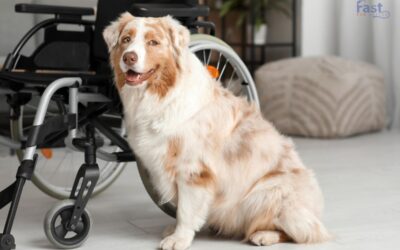How PSD Helps Manage Symptoms of Schizophrenia?

Robert Clendenin, MD
In this article, we’ll dive into how these amazing animals make life easier for people with schizophrenia by offering grounding, reminders, and even alerting others to potential crises. Whether you’re someone seeking additional support or a family member exploring options, here’s everything you need to know about how psychiatric service dogs help manage schizophrenia symptoms.

What is Schizophrenia?
How Psychiatric Service Dogs Help Manage Symptoms of Schizophrenia?
Psychiatric Service Dogs play a vital role in supporting individuals with schizophrenia by providing emotional support, stability, and assistance in managing their symptoms. The presence of a PSD can help reduce anxiety, increase feelings of safety, and enhance the overall quality of life. PSDs are trained to perform specific tasks that aid their handlers in managing symptoms of schizophrenia effectively.
1. Emotional Grounding During Episodes
People with schizophrenia often experience hallucinations, paranoia, or disorganized thoughts. PSD for Schizophrenia offers grounding techniques by touching or leaning against their owners, which helps redirect focus and reduce anxiety during these episodes.
2. Medication Reminders and Routine Support
3. Crisis Alert and Emergency Support
A well-trained PSD can recognize signs of an oncoming mental health crisis, such as a panic attack or disorientation. By alerting the individual—or even a nearby person if the situation worsens—the dog acts as an immediate support system, promoting safety.
4. Reducing Isolation and Encouraging Social Engagement
5. Task Assistance for Daily Functioning
How to Get a Psychiatric Service Dog for Schizophrenia?
1. Online Evaluation
2. In-Person Evaluation
Alternatively, you can consult a licensed mental health provider in person. This route may be preferable if you already have a mental health provider or prefer face-to-face appointments.
Once you have a valid PSD letter, there are a few options to proceed:
- Use an Already Trained Dog: If you currently have a dog that’s already trained to help manage schizophrenia symptoms, they can become your service dog. The PSD letter will validate your dog’s role, allowing them to accompany you in public and assist with daily routines.
- Get a Trained Dog: If you don’t have a trained dog, you can acquire one specifically trained as a PSD. These dogs are professionally trained to perform the tasks that help manage the symptoms of schizophrenia.
- Train a Dog Afterward: Another option is to adopt a dog and train them afterward. Some people prefer training a dog on their own or with the help of a professional trainer to develop the skills necessary to support specific needs.
1. Understand Key Tasks and Roles for a PSD
Before training begins, outline the tasks your dog should perform. For schizophrenia, these tasks might include:
- Emotional Grounding: Training your dog to provide physical grounding by leaning on you or nudging when you’re distressed or disoriented.
- Medication Reminders: Teaching your dog to remind you to take medication by nudging or bringing medication bottles.
- Crisis Response: Training to recognize signs of a crisis, like pacing or severe distress, and to intervene by redirecting focus, finding help, or offering physical support.
2. Start with Basic Obedience Training
Your dog needs a strong foundation in basic obedience skills before PSD-specific training. This includes commands like:
- Sit, Stay and Come: Ensuring your dog reliably follows these basic commands is crucial for effective PSD work.
- Focus Training: Teach your dog to maintain eye contact or “focus” on you, which helps with grounding during stressful situations.
Tip: Use positive reinforcement methods—like treats, praise, and petting—to reward your dog for following commands. Consistent practice is key.
3. Teach Task-Specific Training for Schizophrenia Support
Once your dog is solid with obedience, begin training for specific tasks:
- Deep Pressure Therapy (DPT): DPT is helpful for grounding. Train your dog to apply gentle pressure by lying across your legs or chest when you’re feeling overwhelmed. Start by rewarding them when they rest in this position, gradually increasing the time they stay there on command.
- Nudging for Medication: Set a consistent schedule for your dog to “nudge” you as a reminder. Begin by giving the command when it’s time to take medication, rewarding them each time they gently nudge or paw at you.
- Alert to Signs of Distress: Identify signs of distress or symptoms like pacing, and reward your dog when they respond to these signs by offering a calming behavior (e.g., placing a paw on you).
4. Practice in Real-Life Settings
Expose your dog to real-life environments to ensure they can perform tasks in various settings. Gradually introduce them to new places like grocery stores, parks, and other public spaces, where distractions are common, helping them get comfortable performing tasks reliably.
Training is an ongoing process. Even once your dog has learned to manage specific schizophrenia-related tasks, reinforce their training regularly to keep their skills sharp. You may need to adjust commands or add new tasks over time as your needs evolve.
How To Choose the Right Psychiatric Service Dog Breed for Schizophrenia?
Selecting the ideal Psychiatric Service Dog (PSD) breed to support schizophrenia requires attention to temperament, energy levels, and mobility needs. Here are some top PSD breeds and their suitability for helping manage schizophrenia symptoms:
Key Considerations:
- Temperament: Choose breeds known for calm, steady temperaments that remain non-reactive in crowds. Ideal PSDs are affectionate, not overly excitable, and capable of handling high-stress situations.
- Energy Levels: Some may benefit from a high-energy breed like a Border Collie for regular exercise and socialization, while others prefer low-energy breeds like Cavalier King Charles Spaniels, suited for more relaxed lifestyles.
- Size & Mobility Needs: For grounding and stability tasks, larger breeds like Golden Retrievers or Great Danes can provide physical support, while smaller breeds may be easier to manage for some individuals.
Best PSD Breeds for Schizophrenia:
1. Labrador Retriever
- Strengths: Gentle, adaptable, and highly trainable.
- Best for: Emotional grounding, medication reminders, and social support.
2. Golden Retriever
- Strengths: Affectionate, reliable, and responsive to training.
- Best for: Deep Pressure Therapy (DPT) and grounding during episodes.
3. German Shepherd
- Strengths: Attentive, protective, and highly focused.
- Best for: Crisis response, guiding, and providing a sense of security.
4. Standard Poodle
- Strengths: Intelligent, hypoallergenic, and precise.
- Best for: Emotional support and medication reminders.
5. Border Collie
- Strengths: Highly intelligent and structured.
- Best for: Task-based assistance and distress alerts.
6. Cavalier King Charles Spaniel
- Strengths: Small, calming, and gentle.
- Best for: Companionship, emotional support, and DPT.
7. Great Dane
- Strengths: Calm, dependable, and physically supportive.
- Best for: DPT, crisis response, and guidance in public.
Each breed brings specific strengths to the role of a PSD. Consider your lifestyle, support needs, and environment to find the breed that best complements your requirements. Training should also focus on your dog’s comfort with tasks, ensuring they thrive in the role.
What are the Legal Rights and Protections for Psychiatric Service Dogs?
- Americans with Disabilities Act (ADA): In the U.S., PSDs are covered under the ADA, allowing them access to public spaces like restaurants, stores, and hotels.
- Housing Rights: PSDs are also protected under the Fair Housing Act (FHA), which prohibits housing providers from denying accommodation based on the need for a service dog, even if there’s a no-pets policy.
- Employment Rights: While the ADA doesn’t explicitly cover PSDs in the workplace, some employers may accommodate PSDs as reasonable accommodations for employees with schizophrenia.
- Air Carrier Access Act (ACAA): The ACAA provides additional protections for individuals traveling with their Psychiatric Service Dogs. Under this act, airlines are required to allow PSDs to accompany their handlers in the cabin, ensuring access to air travel for individuals with psychiatric disabilities.
How to Care for Your PSD With Schizophrenia?
1. Routine and Structure
- Consistent Daily Routine: Set regular times for feeding, walking, and task practice. Routine helps your PSD stay focused and prepared, which is essential for responding effectively to your needs.
- Stable Patterns: Familiar schedules reduce stress for both you and your PSD, reinforcing their ability to detect and respond to distress signals.
2. Mental and Physical Stimulation
- Daily Exercise: Activities like walks, fetch, or runs keep your PSD fit and responsive, while also offering grounding support during stressful moments.
- Mental Challenges: Engage your PSD’s mind with tasks like agility training, or problem-solving. This keeps their task response sharp and helps maintain focus.
3. Health Maintenance
- Routine Vet Visits: Keep vaccinations and check-ups current to ensure your PSD’s long-term health.
- Balanced Nutrition: Feed a high-quality diet to support your dog’s energy and alertness.
- PSD Rest and Recovery: Allow downtime to prevent burnout, ensuring they remain attentive and effective in their role.
Keeping your PSD well cared for is key to building a reliable partnership, helping them stay responsive and supportive in managing schizophrenia symptoms.
Conclusion
Frequently Asked Questions
What Are The Specific Tasks a PSD Can Perform For Someone With Schizophrenia?
Can a Psychiatric Service Dog Help Manage Hallucinations Associated With Schizophrenia?
How Do I Know If My Dog is Suitable To Be Trained As a Psychiatric Service Dog For Schizophrenia?
How Can a Psychiatric Service Dog Assist During a Crisis Related To Schizophrenia?
What is The Cost of Getting a Psychiatric Service Dog For Schizophrenia?
How Do You Qualify For A Psychiatric Service Dog For Schizophrenia?
Is There Financial Assistance Available For Getting A Psd For Schizophrenia?
Can I Train My Dog As A Psd After They’re Already A Pet?
How Long Does It Take To Train A Dog As A Psychiatric Service Dog?
Can A Psychiatric Service Dog Help With Medication Management For Schizophrenia?
What Should I Look For In A Trainer For My Psychiatric Service Dog?
Post Author
Prince Sharma
Related Articles
How to Get a Psychiatric Service Dog in Massachusetts?
How to Get a Psychiatric Service Dog in Massachusetts?To get a psychiatric service dog in Massachusetts, you need a recommendation from a licensed mental health professional and ensure the dog is trained to perform specific tasks related to your...
How To Get a Psychiatric Service Dog in Wisconsin?
How to Get a Psychiatric Service Dog in Wisconsin?To get a psychiatric service dog in Wisconsin, you need a diagnosis from a licensed mental health professional stating that a service dog would assist with your condition. Next, either train your dog...
How To Get A Psychiatric Service Dog in Washington?
How To Get a Psychiatric Service Dog in Washington?To get a Psychiatric Service Dog (PSD) in Washington, you must have a diagnosed mental or emotional disability that significantly impacts your daily life, and the dog must be trained to perform tasks...
Live and Fly Free with Your PSD!






